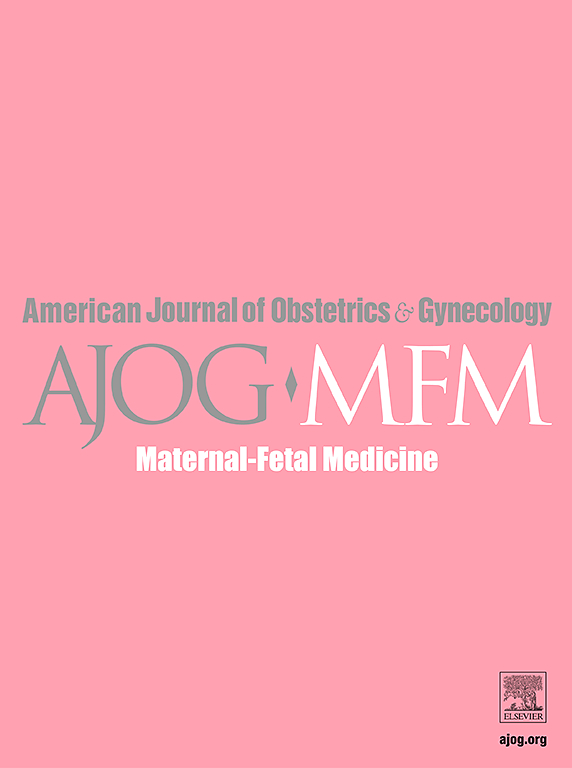High- vs low-dose oxytocin protocols for labor induction: a systematic review and meta-analysis
IF 3.1
2区 医学
Q1 OBSTETRICS & GYNECOLOGY
American Journal of Obstetrics & Gynecology Mfm
Pub Date : 2025-05-05
DOI:10.1016/j.ajogmf.2025.101691
引用次数: 0
Abstract
Objective
This systematic review aimed to synthesize available literature reporting maternal and neonatal outcomes of induction of labor using high- vs low-dose oxytocin protocols.
Data Sources
PubMed, Embase, Scopus, CINAHL, and Cochrane databases, and ClinicalTrials.gov were searched from inception to January 17, 2023.
Study Eligibility Criteria
Studies with the following criteria were included: randomized or observational studies conducted with pregnant individuals, published in English, that compared low-dose (starting dose 0.5–2 milliunits/min increased by 1–2 milliunits/min every 15–40 minutes) vs high-dose (≥4 milliunits/min increased by 3–6 milliunits/min every 15–40 minutes) oxytocin infusion protocols for induction of labor. Studies of individuals with fetal death were excluded.
Study Appraisal and Synthesis Methods
Two reviewers independently extracted data and appraised study quality following the PRISMA guidelines and using the Cochrane risk of bias assessment tools. The primary outcome was cesarean delivery. Secondary outcomes included spontaneous vaginal delivery, operative vaginal delivery, duration of labor induction, uterine tachysystole, and maternal and neonatal morbidity outcomes. Pooled relative risks (RR) with 95% confidence intervals (CI) were calculated using random-effects models. Heterogeneity was assessed statistically using the Higgins’ I2 test and visually using a funnel plot.
Results
Six studies (two randomized controlled trials, four observational studies) were included, encompassing 7850 deliveries (3957 in the high-dose group and 3893 in the low-dose group). Overall, there was no difference in the risk of cesarean delivery following induction of labor with a high-dose oxytocin protocol compared with a low-dose protocol (26.0% vs 28.4%, pooled RR 1.02, 95% CI 0.85–1.21). There were also no differences in the likelihood of cesarean delivery for nonreassuring fetal status or neonatal morbidity, or in the duration of labor. Induction with high-dose oxytocin was associated with a lower frequency of postpartum hemorrhage, compared with a low-dose protocol (7.6% vs 9.9%, RR 0.78, 95% CI 0.66–0.92). Details of high- and low-dose protocols varied widely between studies, which all were at medium or high risk of bias. There was moderate heterogeneity (I2=45.5%), and no evidence of publication bias (Harbord test, P=.74).
Conclusions
A synthesis of the existing literature demonstrates no difference in the frequency of cesarean delivery following induction of labor using a high- vs low-dose oxytocin protocol. However, this review highlights the methodological limitations of the few available published studies and the need for high-quality trials to guide optimal oxytocin dosing for labor induction.
用于引产的高剂量vs低剂量催产素方案:系统回顾和荟萃分析。
目的:本系统综述旨在综合现有文献报道高剂量与低剂量催产素方案引产的产妇和新生儿结局。数据来源:PubMed, Embase, Scopus, CINAHL和Cochrane数据库和ClinicalTrials.gov从成立到2023年1月17日检索。研究资格标准:纳入了以下标准的研究:随机或观察性研究,对怀孕个体进行,发表英文,比较低剂量(起始剂量0.5-2毫单位/分钟,每15-40分钟增加1-2毫单位/分钟)和高剂量(≥4毫单位/分钟,每15-40分钟增加3-6毫单位/分钟)催产素输注引产方案。排除了对胎儿死亡个体的研究。研究评价和综合方法:两位审稿人按照PRISMA指南并使用Cochrane偏倚风险评估工具独立提取数据并评价研究质量。主要结局为剖宫产。次要结局包括自然阴道分娩、手术阴道分娩、引产持续时间、子宫心动过速、产妇和新生儿发病率结局。采用随机效应模型计算95%置信区间(CI)的合并相对风险(RR)。异质性采用希金斯I2检验进行统计评估,视觉上采用漏斗图。结果:纳入6项研究(2项随机对照试验,4项观察性研究),共7850例分娩(高剂量组3957例,低剂量组3893例)。总体而言,高剂量催产素方案与低剂量方案在引产后剖宫产的风险方面没有差异(26.0% vs 28.4%,合并RR 1.02, 95% CI 0.85-1.21)。在胎儿状态不稳定或新生儿发病率或分娩时间方面,剖宫产的可能性也没有差异。与低剂量方案相比,高剂量催产素诱导与产后出血的发生率较低相关(7.6% vs 9.9%, RR 0.78, 95% CI 0.66-0.92)。高剂量和低剂量方案的细节在研究之间差异很大,所有研究都处于中等或高度偏倚风险。存在中等异质性(I2 = 45.5%),无发表偏倚证据(Harbord检验,p=0.74)。结论:综合现有文献表明,使用高剂量和低剂量催产素方案诱导分娩后剖宫产的频率没有差异。然而,这篇综述强调了为数不多的已发表研究的方法学局限性,以及需要高质量的试验来指导引产时催产素的最佳剂量。
本文章由计算机程序翻译,如有差异,请以英文原文为准。
求助全文
约1分钟内获得全文
求助全文
来源期刊

American Journal of Obstetrics & Gynecology Mfm
Medicine-Medicine (all)
CiteScore
7.40
自引率
3.20%
发文量
254
审稿时长
40 days
期刊介绍:
The American Journal of Obstetrics and Gynecology (AJOG) is a highly esteemed publication with two companion titles. One of these is the American Journal of Obstetrics and Gynecology Maternal-Fetal Medicine (AJOG MFM), which is dedicated to the latest research in the field of maternal-fetal medicine, specifically concerning high-risk pregnancies. The journal encompasses a wide range of topics, including:
Maternal Complications: It addresses significant studies that have the potential to change clinical practice regarding complications faced by pregnant women.
Fetal Complications: The journal covers prenatal diagnosis, ultrasound, and genetic issues related to the fetus, providing insights into the management and care of fetal health.
Prenatal Care: It discusses the best practices in prenatal care to ensure the health and well-being of both the mother and the unborn child.
Intrapartum Care: It provides guidance on the care provided during the childbirth process, which is critical for the safety of both mother and baby.
Postpartum Issues: The journal also tackles issues that arise after childbirth, focusing on the postpartum period and its implications for maternal health. AJOG MFM serves as a reliable forum for peer-reviewed research, with a preference for randomized trials and meta-analyses. The goal is to equip researchers and clinicians with the most current information and evidence-based strategies to effectively manage high-risk pregnancies and to provide the best possible care for mothers and their unborn children.
 求助内容:
求助内容: 应助结果提醒方式:
应助结果提醒方式:


